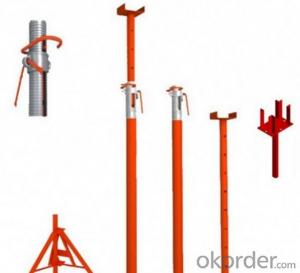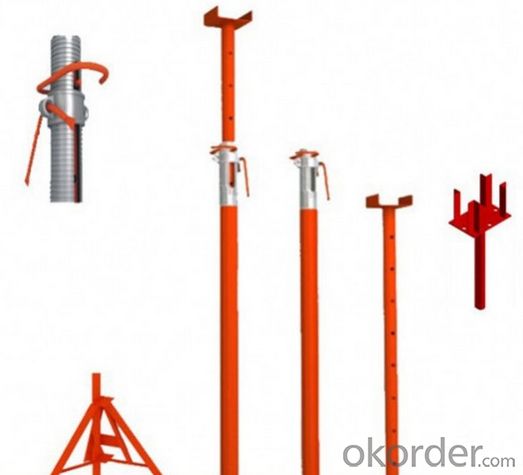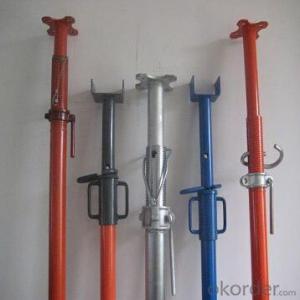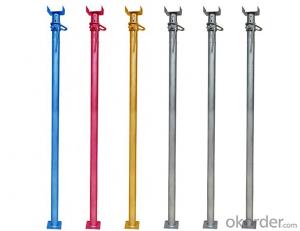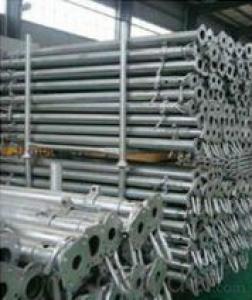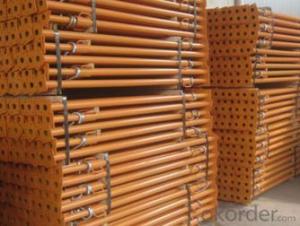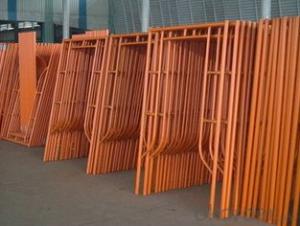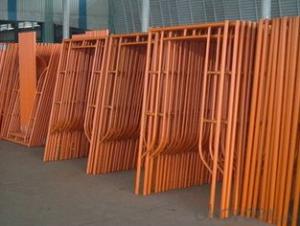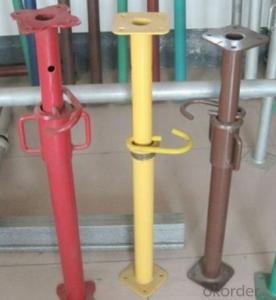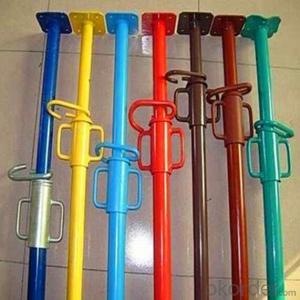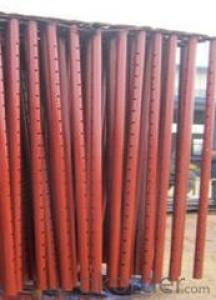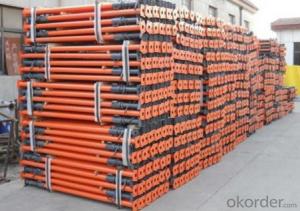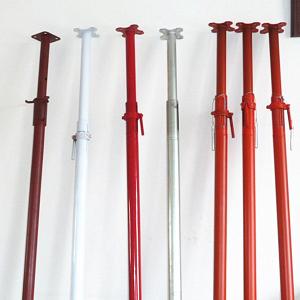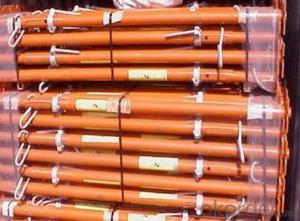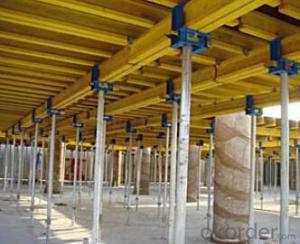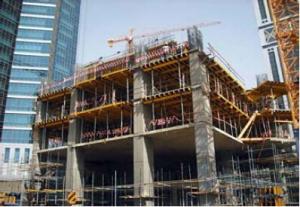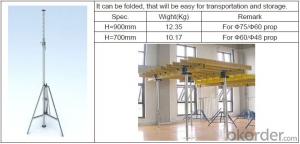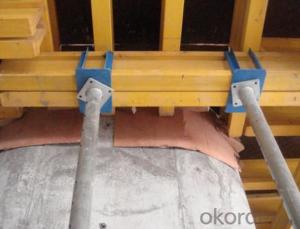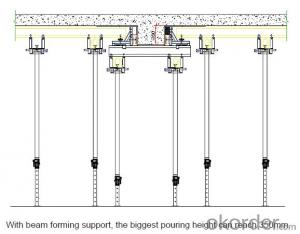1-8m Adjustable Scaffolding Steel Props/ Shoring Props
- Loading Port:
- Tianjin
- Payment Terms:
- TT OR LC
- Min Order Qty:
- 10000 PCS
- Supply Capability:
- 10000 PCS/month
OKorder Service Pledge
OKorder Financial Service
You Might Also Like
Quick Details
| Model Number: | 1-8m | ||||
| Surface treatment: | painted, powder coated, galvanized | Common height: | 1-8m (3.2-27 feet) | Outer tube diameter: | 40-90mm(1 1/4"-3'') |
| Inner tube diameter: | 30-90mm (1"-3'') | Wall thickness of tube: | 1.6-4mm (0.06''-0.16'') | Pin: | straight / hooked |
| Top plate /Top head: | flat(square/flower shaped), U shaped as clients' requirements | Base plate/Base head: | flat (square/flower shaped) as clients' requirements | Colour: | blue, orange, black, yellow, red, sliver as clients' requirements |
| More contacts: | Skype: watson2013W |
Packaging & Delivery
| Packaging Detail: | standard package, or as clients' requirements |
| Delivery Detail: | generally 1-3 weeks based on the quantity and specification |
Specifications
1. full types
2. large supply
3. ISO quality certificate
4. all kinds of surface treatment
5. accept customized order
WHY YOU CHOOSE US:
1. We have many years of experiences.
2. We have many certificates which can assure the quality of our products.
3. We have many projects in the shipyard companies of south of China.
4. We have strong engineering team that can give best solution for your projects.
5. We can take you to visit our factory.
6.Good after-sale service offered,please get back if you have any question.
Our Service:
1.Your inquiry related to our product & price will be replied within 24hours.
2.Well-trained &experienced staff are to answer all your inquiries professional in English of
course.
3.Working time: 8:00am - 5:30pm, Monday to Friday. OEM is highly welcomed.
4.We have strong R&D team here to help.
5.Your business relationship with us will be confidential to any third party.
6. Good after-sale service offered, please get back if you got question.
- Q: Can steel props be used for formwork support?
- Yes, steel props can be used for formwork support.
- Q: Can steel props be used for supporting temporary exhibition stands?
- Certainly, temporary exhibition stands can be supported by steel props. These props possess robustness and longevity, rendering them an apt choice for carrying the weight of exhibition stands and the materials employed in their assembly. Adjusting them to the desired height is a breeze, and they furnish stability and reinforcement to the structure. Furthermore, steel props can be utilized in diverse arrangements to accommodate a range of stand designs and layouts. In conclusion, steel props emerge as a dependable option for supporting temporary exhibition stands.
- Q: How do you determine the appropriate height of a steel prop?
- To determine the appropriate height of a steel prop, several factors need to be considered. Firstly, the load that the prop will be supporting plays a crucial role. It is essential to know the weight or load-bearing capacity of the object or structure that the prop will be supporting. This information can be obtained from architectural or engineering drawings, or by consulting with a structural engineer. Secondly, the distance between the ground and the point where the prop will be placed needs to be measured accurately. This measurement will help determine the minimum and maximum height range for the steel prop. Another factor to consider is the type of prop being used. Different types of props have different weight-bearing capacities and adjustable height ranges. It is important to select a prop that is suitable for the specific load and height requirements. Additionally, the condition of the ground or surface where the prop will be placed should be assessed. Uneven or unstable ground may require additional measures, such as using base plates or adjustable feet, to ensure the stability and safety of the prop. Lastly, compliance with local regulations and safety standards is crucial. It is important to follow any guidelines or regulations set forth by local authorities or relevant industry standards to ensure the appropriate height and safety of the steel prop. Overall, determining the appropriate height of a steel prop involves assessing the load, measuring the distance, selecting the right prop type, considering the ground conditions, and adhering to safety regulations. Consulting with professionals, such as structural engineers or experienced contractors, can also provide valuable guidance in determining the appropriate height for a steel prop in specific construction scenarios.
- Q: Can steel props be used in the construction of prefabricated buildings?
- Yes, steel props can be used in the construction of prefabricated buildings. Steel props, also known as adjustable steel props or scaffolding props, are commonly used in construction projects to provide temporary support to walls, ceilings, and floors. Prefabricated buildings are constructed using pre-made components that are manufactured off-site and then assembled on-site. Steel props are often used during the assembly process to provide stability and support to the prefabricated components until they are securely fixed in place.
- Q: Can steel props be used for temporary support during tunnel construction?
- Yes, steel props can be used for temporary support during tunnel construction. Steel props are commonly used in construction projects to provide temporary support to structures, including tunnels. They are adjustable, allowing for easy installation and removal, and can withstand heavy loads. Steel props provide stability and structural integrity during the excavation and construction process, ensuring the safety of workers and the overall success of the project.
- Q: Are steel props suitable for use in the construction of bridges?
- Indeed, steel props prove to be a viable option for incorporating in bridge construction projects. Commonly referred to as shoring systems or temporary supports, steel props are extensively utilized in bridge construction to offer provisional assistance to the structure during construction or repair activities. Steel props possess numerous advantages that render them well-suited for bridge construction. Primarily, steel exhibits robustness and durability, making it capable of enduring substantial loads and adverse weather conditions. Consequently, it becomes an ideal choice for providing temporary support to various bridge components, such as beams, girders, or decks. Moreover, steel props boast adjustability, facilitating effortless installation and customization according to the specific requirements of the bridge construction project. These props can be extended or retracted to attain the desired support height and can be effortlessly secured in place by utilizing diverse locking mechanisms. This adjustability ensures that the temporary support system can adequately adapt to the evolving demands of the construction process. Additionally, steel props are lightweight and easily transportable, contributing to their convenience in bridge construction projects. Their modular design permits swift assembly and disassembly, ultimately saving time and labor costs. Furthermore, steel props demonstrate versatility and can be employed in various bridge construction scenarios, including new bridge construction, bridge repairs, or bridge widening endeavors. They can be employed in conjunction with other temporary support systems, such as formwork or scaffolding, to guarantee the stability and safety of the bridge throughout the construction process. In conclusion, due to their strength, durability, adjustability, versatility, and user-friendliness, steel props prove to be suitable for bridge construction. By providing temporary support to bridge components, they ensure the stability and safety of the structure during construction or repair work.
- Q: Are steel props suitable for use in the construction of office buildings?
- Yes, steel props are suitable for use in the construction of office buildings. Steel props, also known as adjustable steel props or steel shore props, are commonly used in construction projects to support temporary structures and provide vertical support during the construction process. Steel props offer numerous benefits that make them suitable for use in office building construction. Firstly, they are highly durable and robust, capable of withstanding heavy loads and adverse weather conditions. This ensures the stability and safety of the building during construction. Secondly, steel props are adjustable, allowing for flexibility in design and construction. They can be easily extended or retracted to achieve the desired height, making them adaptable to different floor levels and construction phases. This adjustability also enables efficient and quick installation, reducing construction time and cost. Furthermore, steel props provide excellent load-bearing capacity, which is essential for supporting the weight of concrete slabs, beams, and other construction materials. They offer reliable support and prevent structural damage or collapse during the construction process. Moreover, steel props are lightweight compared to other support systems, making them easier to handle, transport, and install. Additionally, they require minimal maintenance, which further contributes to their suitability for office building construction. In conclusion, steel props are indeed suitable for use in the construction of office buildings. Their strength, adjustability, load-bearing capacity, and durability make them an ideal choice for providing temporary support during construction and ensuring the stability and safety of the building.
- Q: Are steel props suitable for supporting temporary stages or platforms with heavy equipment?
- Steel props, also known as adjustable steel props or steel scaffolding props, are a suitable option for supporting temporary stages or platforms that require heavy equipment. These props, made from high-quality steel, guarantee durability and a strong load-bearing capacity. They are designed to provide stable support for various construction applications, including temporary stages and platforms with heavy equipment. One of the advantages of steel props is their adjustable height feature, which allows them to be set at the desired level to provide the necessary support for the stage or platform. This adjustability makes steel props versatile and suitable for meeting different height requirements. Moreover, steel props have a high load-bearing capacity, enabling them to support heavy equipment. They are designed to withstand significant loads and distribute weight evenly, ensuring the stability and safety of the stage or platform. Another benefit of using steel props is their easy installation and dismantling process. They can be quickly set up and adjusted to the required height, saving time and effort during construction. Additionally, steel props can be easily transported to different locations, making them convenient for temporary stages or platforms that need frequent movement. In conclusion, steel props provide a reliable and stable support system for temporary stages or platforms with heavy equipment. Their high load-bearing capacity, durability, adjustability, and ease of installation make them an ideal choice. They ensure the safety and functionality of the stage or platform during events or construction projects.
- Q: Can steel props be used for supporting temporary catwalks?
- Yes, steel props can be used for supporting temporary catwalks. Steel props are strong and sturdy, making them suitable for providing the necessary support and stability required for temporary catwalk structures.
- Q: Can steel props be used for supporting temporary bridges or culverts?
- Yes, steel props can be used for supporting temporary bridges or culverts. Steel props are strong and durable, making them suitable for handling the weight and load requirements of temporary structures like bridges or culverts. Additionally, steel props offer adjustable heights and stability, allowing for easy installation and customization to fit specific project needs.
Send your message to us
1-8m Adjustable Scaffolding Steel Props/ Shoring Props
- Loading Port:
- Tianjin
- Payment Terms:
- TT OR LC
- Min Order Qty:
- 10000 PCS
- Supply Capability:
- 10000 PCS/month
OKorder Service Pledge
OKorder Financial Service
Similar products
Hot products
Hot Searches
Related keywords
